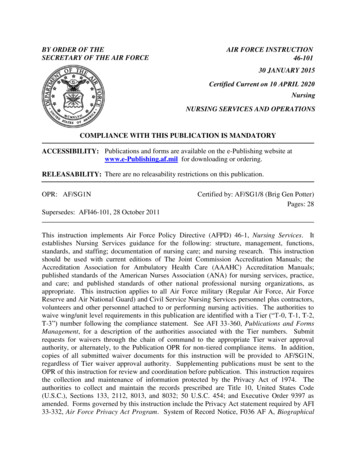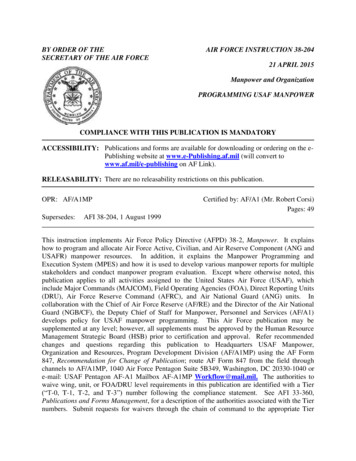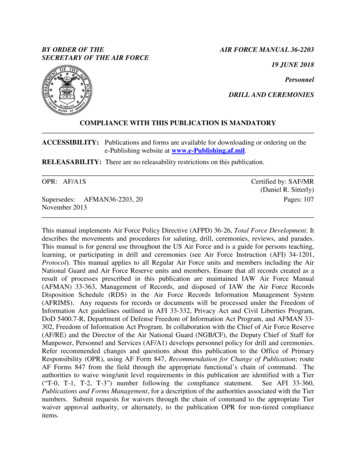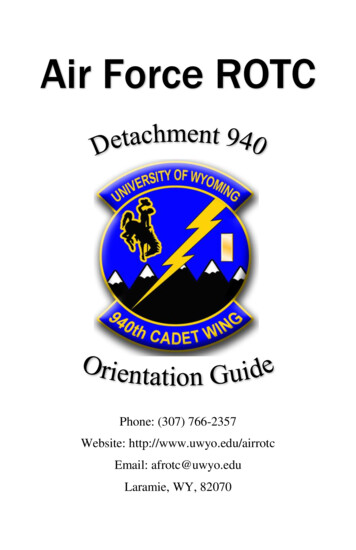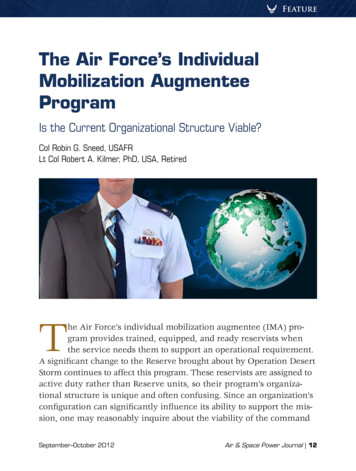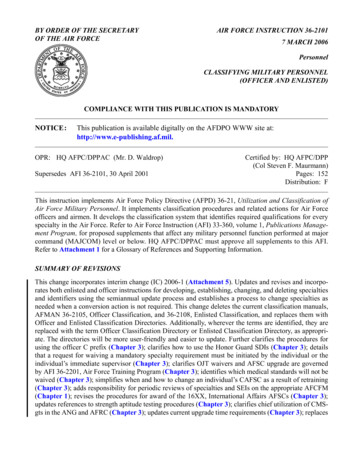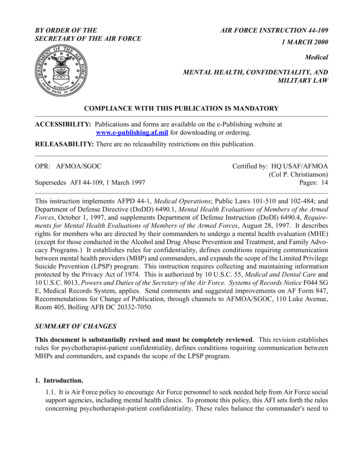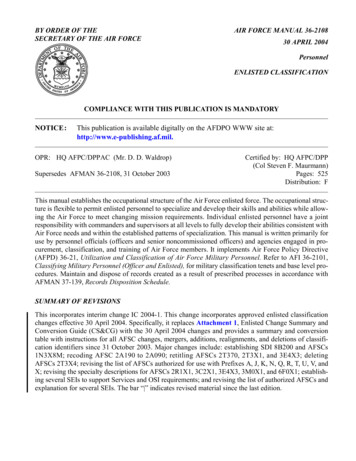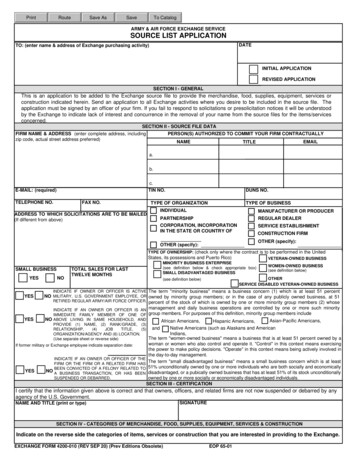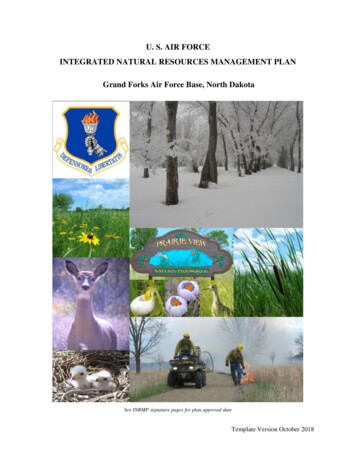
Transcription
U. S. AIR FORCEINTEGRATED NATURAL RESOURCES MANAGEMENT PLANGrand Forks Air Force Base, North DakotaSee INRMP signature pages for plan approval dateTemplate Version October 2018
INTEGRATED NATURAL RESOURCES MANAGEMENT PLANABOUT THIS PLANThis installation-specific Environmental Management Plan (EMP) is based on the United States Air Force’s(USAF) standardized Integrated Natural Resources Management Plan (INRMP) template. This INRMP hasbeen developed in cooperation with applicable stakeholders, which includes Sikes Act cooperating agenciesand/or local equivalents, to document how natural resources will be managed. Where applicable, externalresources, including Air Force Instructions (AFIs); Department of Defense Instructions (DoDIs); USAFPlaybooks; federal, state, and local requirements; Biological Opinions; and permits are referenced.Certain sections of this INRMP begin with standardized, USAF-wide “common text” language that addressUSAF and Department of Defense (DoD) policy and federal requirements. This common text language isrestricted from editing to ensure that it remains standard throughout all plans. Immediately following theUSAF-wide common text sections are installation sections. The installation sections contain installationspecific content to address local and/or installation-specific requirements. Installation sections areunrestricted and are maintained and updated by the approved plan owner.NOTE: The terms “Natural Resources Manager,” “NRM,” and “NRM/POC” are used throughout thisdocument to refer to the installation person responsible for the natural resources program, regardless ofwhether this person meets the qualifications within the definition of a natural resources managementprofessional in DoDI 4715.03, Natural Resources Conservation Program.Page 2 of 132
INTEGRATED NATURAL RESOURCES MANAGEMENT PLANTABLE OF CONTENTSABOUT THIS PLAN . 2TABLE OF CONTENTS . 3DOCUMENT CONTROL. 6Standardized INRMP Template . 6Installation INRMP . 6INRMP APPROVAL/SIGNATURE PAGES . 7EXECUTIVE SUMMARY . 81.0 OVERVIEW AND SCOPE . 91.1 Purpose and Scope . 91.2 Management Philosophy . 101.3 Authority . 111.4 Integration with Other Plans . 122.0 INSTALLATION PROFILE . 122.1 Installation Overview . 132.1.1 Location and Area . 132.1.2 Installation History. 142.1.3 Military Missions . 162.1.4 Natural Resources Needed to Support the Military Mission. 162.1.5 Surrounding Communities . 172.1.6 Local and Regional Natural Areas . 172.2 Physical Environment . 202.2.1 Climate . 202.2.2 Landforms . 212.2.3 Geology and Soils . 212.2.4 Hydrology . 242.3 Ecosystems and the Biotic Environment . 242.3.1 Ecosystem Classification . 242.3.2 Vegetation . 262.3.3 Fish and Wildlife. 292.3.4 Threatened and Endangered Species and Species of Concern . 352.3.5 Wetlands and Floodplains . 382.3.6 Other Natural Resource Information. 402.4 Mission and Natural Resources . 422.4.1 Natural Resource Constraints to Mission and Mission Planning . 422.4.2 Land Use . 432.4.3 Current Major Mission Impacts on Natural Resources . 432.4.4 Potential Future Mission Impacts on Natural Resources . 483.0 ENVIRONMENTAL MANAGEMENT SYSTEM . 504.0 GENERAL ROLES AND RESPONSIBILITIES . 515.0 TRAINING . 526.0 RECORDKEEPING AND REPORTING . 53Page 3 of 132
INTEGRATED NATURAL RESOURCES MANAGEMENT PLAN6.1 Recordkeeping . 536.2 Reporting . 537.0 NATURAL RESOURCES PROGRAM MANAGEMENT . 537.1 Fish and Wildlife Management . 547.2 Outdoor Recreation and Public Access to Natural Resources . 597.3 Conservation Law Enforcement . 637.4 Management of Threatened and Endangered Species, Species of Concern, and Habitats . 637.5 Water Resource Protection . 707.6 Wetland Protection . 737.7 Grounds Maintenance . 777.8 Forest Management . 847.9 Wildland Fire Management . 887.10 Agricultural Outleasing . 907.11 Integrated Pest Management Program . 937.12 Bird/Wildlife Aircraft Strike Hazard (BASH) . 967.13 Coastal Zone and Marine Resources Management . 1027.14 Cultural Resources Protection . 1027.15 Public Outreach . 1037.16 Climate Change Vulnerabilities . 1047.17 Geographic Information Systems (GIS). 1058.0 MANAGEMENT GOALS AND OBJECTIVES. 1069.0 INRMP IMPLEMENTATION, UPDATE, AND REVISION PROCESS . 1119.1 Natural Resources Management Staffing and Implementation . 1119.2 Monitoring INRMP Implementation . 1129.3 Annual INRMP Review and Update Requirements . 11210.0 ANNUAL WORK PLANS . 11211.0 REFERENCES . 11311.1 Standard References (Applicable to all USAF installations) . 12411.2 Installation References . 12412.0 ACRONYMS . 12612.1 Standard Acronyms (Applicable to all USAF installations). 12612.2 Installation Acronyms . 12613.0 DEFINITIONS . 12613.1 Standard Definitions (Applicable to all USAF installations) . 12613.2 Installation Definitions . 12614.0 APPENDICES . 12614.1. Standard Appendices . 126Appendix A. Annotated Summary of Key Legislation Related to Design and Implementation of theINRMP . 12614.2. Installation Appendices . 132Appendix B. State and Federal Permits. . 132Appendix C. Threatened and Endangered & Species of Concern Plans. . 132Appendix D. Fish and Wildlife Management. . 132Appendix E. Forestry Management Plans. 132Page 4 of 132
INTEGRATED NATURAL RESOURCES MANAGEMENT PLANAppendix F. Agricultural Hay Lease. . 132Appendix G. Invasive Species. . 132Appendix H. Wetlands Management and Protection. . 132Appendix I. Migratory Bird Protection and Checklist. . 13215.0 ASSOCIATED PLANS . 132Tab 1 – Tier 1 Wildland Fire Management Plan . 132Tab 2 – Bird/Wildlife Aircraft Strike Hazard (BASH) Plan. 132Tab 3 – Integrated Cultural Resources Management Plan (ICRMP). 132Tab 4 – Integrated Pest Management Plan (IPMP) . 132Page 5 of 132
INTEGRATED NATURAL RESOURCES MANAGEMENT PLANDOCUMENT CONTROLStandardized INRMP TemplateIn accordance with (IAW) the Air Force Civil Engineer Center (AFCEC) Environmental Directorate (CZ)Business Rule (BR) 08, EMP Review, Update, and Maintenance, the standard content in this INRMPtemplate is reviewed periodically, updated as appropriate, and approved by the Natural Resources SubjectMatter Expert (SME).This version of the template is current as of 10/03/2018 and supersedes the 2015 version.NOTE: Installations are not required to update their INRMPs every time this template is updated. When itis time for installations to update their INRMPs, they should refer to the eDASH EMP Repository toensure they have the most current version.Installation INRMPRecord of Review – The INRMP is updated no less than annually, or as changes to natural resourcemanagement and conservation practices occur, including those driven by changes in applicable regulations.IAW the Sikes Act and AFMAN 32-7003, Environmental Conservation, the INRMP is required to bereviewed for operation and effect no less than every five years. An INRMP is considered compliant withthe Sikes Act if it has been approved in writing by the appropriate representative from each cooperatingagency within the past five years. Approval of a new or revised INRMP is documented by signature on asignature page signed by the Installation Commander (or designee), and a designated representative of theUnited States Fish and Wildlife Service (USFWS), state fish and wildlife agency, and National Oceanicand Atmospheric Administration (NOAA) Fisheries when applicable (AFMAN 32-7003).Annual reviews and updates are accomplished by the installation Natural Resources Manager (NRM),and/or a Section Natural Resources Media Manager. The installation shall establish and maintain regularcommunications with the appropriate federal and state agencies. At a minimum, the installation NRM (withassistance as appropriate from the Section Natural Resources Media Manager) conducts an annual reviewof the INRMP in coordination with internal stakeholders and local representatives of USFWS, state fishand wildlife agency, and NOAA Fisheries, where applicable, and accomplishes pertinent updates.Installations will document the findings of the annual review in an Annual INRMP Review Summary. Bysigning the Annual INRMP Review Summary, the collaborating agency representative asserts concurrencewith the findings. Any agreed updates are then made to the document, at a minimum updating the workplans.Page 6 of 132
INTEGRATED NATURAL RESOURCES MANAGEMENT PLANGrand Forks Air Force Base – Integrated Natural Resources Management PlanSignature Approvals and Implementation AgreementThe Integrated Natural Resources Management Plan (INRMP) for the 319th Reconnaissance Wing, Grand Forks AirForce Base (GFAFB), North Dakota (ND), has been prepared in accordance with regulations, standards andprocedures of the Department of Defense, the United States Air Force and the Sikes Act (16 United States Code 670a)in cooperation with the United States Fish and Wildlife Service (USFWS) and the North Dakota Game and FishDepartment (NDGFD). This review and mutual agreement by signature of all parties for the base management of fishand wildlife keeps the INRMP current and in operation.The accepted and proposed updates are minor edits to provide current information, or adjust timelines that do notresult in changes to management goals and objectives that are substantively different than those previously agreed toby the cooperating agencies, and would not result in environmental consequences different from those in the existingINRMP.The execution strategy for the INRMP Work Plan is coordinated with participating agencies, and the agencies haveidentified projects they have interest in executing. All other implementation will be performed through otherauthorized acquisition methods.To the extent that resources permit, the USFWS, NDGFD and GFAFB, by signature of their respective agency, dohereby agree to a cooperative plan for the conservation, protection and management of fish and wildlife resourcespresented on GFAFB. By signature below, the certifying official acknowledges the 5-year and subsequent annualreview and coordination of this INRMP.Page 7 of 132
INTEGRATED NATURAL RESOURCES MANAGEMENT PLANEXECUTIVE SUMMARYThis Integrated Natural Resources Management Plan (INRMP) represents a commitment by the U.S.Air Force (USAF) to protect the integrity and value of the natural resources of Grand Forks Air ForceBase (GFAFB). This INRMP has been developed in accordance with Air Force Manual (AFMAN) 327003, Environmental Conservation, the Sikes Act (including amendments), and the Air Force PolicyDirective (AFPD) 32-70, Environmental Quality. This INRMP supports the Department of Defense's(DoD) policy of managing natural resources to support the base mission while practicing the principlesof multiple use and sustained yield. The INRMP provides GFAFB with a description of the base andthe surrounding environment, and integrates an interdisciplinary approach to ecosystem managementwith planning for the military mission. The predominating goal for natural resources planning andmanagement is:Integrate project & management activities by sustaining, promoting, and restoring the health andintegrity of ecosystems and enhancing the human environment at GFAFB, North Dakota.This INRMP is a fundamental part of the Air Force’s ecosystem management program for GFAFB.The objective of ecosystem management on GFAFB is to maintain and improve the sustainability andbiological diversity of unique native ecosystems while supporting the specific military mission atGFAFB. Goals were formulated from a comprehensive scientific analysis of regulatory requirementsand the condition of natural resources on GFAFB. This plan identifies specific objectives and projectswhich, if implemented, contribute to the achievement of each goal. Further implementation of theINRMP will help ensure that GFAFB continues to implement a multiple-use approach to supportpresent and future mission requirements while preserving ecosystem integrity. General predominantobjectives of the GFAFB INRMP are: To outline the military mission and its effects on the natural resources on the base;To recommend guidelines for the management and protection of natural and cultural resources onthe base;Protect native species and discourage non-native, invasive, noxious and exotic species;To monitor and maintain biological diversity and sustainability of mission training needs;To describe the physical characteristics of the base; andTo recommend solutions or procedures available to assist in the resolution of natural resource andbase mission concernsChapter 10 contains a work plan to implement the goals/objectives/projects of this document; this plancan be updated to document annual progress and funding. In addition, performance requirements areprovided for each goal and they establish appropriate monitoring for project oversight. Monitoring thesuccess or failure of INRMP projects provides an opportunity to use adaptive management on allproposed goals and objectives. Adaptive management can apply remedies to operational actionsadversely affecting the function and composition of ecosystems. Monitoring the results can lead to achange in management strategy outlined in this plan and allows update of the base’s EnvironmentalManagement System.Page 8 of 132
INTEGRATED NATURAL RESOURCES MANAGEMENT PLAN1.0 OVERVIEW AND SCOPEThis INRMP was developed to provide for effective management and protection of natural resources.It summarizes the natural resources present on the installation and outlines strategies to adequatelymanage those resources. Natural resources are valuable assets of the USAF. They provide the naturalinfrastructure needed for testing weapons and technology, as well as for training military personnel fordeployment. Sound management of natural resources increases the effectiveness of USAF adaptabilityin all environments. The USAF has stewardship responsibility for the physical lands on whichinstallations are located to ensure all natural resources are properly conserved, protected, and used insustainable ways. The primary objective of the USAF natural resources program is to sustain, restore,and modernize natural infrastructure to ensure operational capability and no net loss in the capabilityof USAF lands to support the military mission of the installation. The plan outlines and assignsresponsibilities for the management of natural resources, discusses related concerns, and providesprogram management elements that will help to maintain or improve the natural resources within thecontext of the installation’s mission. The INRMP is intended for use by all installation personnel. TheSikes Act is the legal driver for the INRMP.1.1 Purpose and ScopeThis INRMP has been developed for use by GFAFB in accordance with AFMAN 32-7003 –Environmental Conservation, AFPD 32-70 - Environmental Quality, and the provisions of the SikesAct (16 United States Code [U.S.C.] 670a et seq.). GFAFB is located in eastern North Dakota,approximately 15 miles west of the City of Grand Forks, ND (See GFAFB Regional Location).Integrated natural resources planning provides GFAFB with a description of the installation (e.g.,location, history, and mission), information about the surrounding physical and biotic environment,and a guide to managing natural resources consistent with the mission requirements. Furthermore, theINRMP recommends various management practices, in compliance with Federal, state, and localstandards, designed to mitigate negative impacts and to enhance the positive effects of the installation’smission on local ecosystems.The purpose of the INRMP is to serve as guidance for natural resources management at GFAFB. ThisINRMP integrates all aspects of natural resource management, as well as the management of sensitivespecies, wetlands, watershed protection, fish and wildlife, outdoor recreation, and public access withthe current military mission. Other studies relevant to these activities will be consulted and integratedinto this plan. The INRMP enables managers to: Be aware of the past, present, and projected future condition of installation natural resources;Identify management issues and specific concerns for each type of natural resource present;Understand the installation goals and objectives for the protection and enhancement of theseresources; andEnsure integration of the natural resource conservation program with the Air Force mission.This approach to resource management attempts to balance human-centered multiple uses of the naturalenvironment such as direct mission support, agriculture production, planning, safety, cultural resources andoutdoor recreational uses with the preservation and sustainment of ecosystem functions and theconservation of biological diversity. When fully coordinated with appropriate federal and state agencies,this INRMP fulfills the Sikes Act (16 U.S.C. 670 et. seq.) definition of a cooperative plan.Page 9 of 132
INTEGRATED NATURAL RESOURCES MANAGEMENT PLANGFAFB Regional LocationThe goals and objectives of the plan will be reviewed annually by the INRMP tripartite and installationstakeholders, and updated annually. Major revisions may be required by the Air Force wheneverplanning or development projects and mission changes are proposed, if there are biophysical changes(climate change impact), or if there are federal threatened and endangered species changes that impactGFAFB. This plan is a dynamic document striving to integrate all aspects of natural resourcesmanagement with each other and the rest of the installation’s mission. Its goals and specific objectivesmust be given consideration early in the planning process to accommodate potential project andmission changes that may occur on the installation.1.2 Management PhilosophyAs part of its mission, the USAF has chosen to be a national leader in environmental and naturalresources stewardship. The vitality of natural resources must be ensured in order to achieve its militarymission. The USAF seeks to develop a program facilitating interagency collaboration and enhancinginteragency resource stewardship while allowing training activities to occur, now and in the future. ByPage 10 of 132
INTEGRATED NATURAL RESOURCES MANAGEMENT PLANworking together on an eco-regional scale, the USAF and its neighbors can practice collaborativeecosystem management, conserve biodiversity, and sustain the mission of GFAFB. As a steward ofnatural resources, GFAFB acknowledges its commitment to be a conservation leader for its designatedareas.Conservation is an integration or blending of natural resources management to maintain ecosystemintegrity. This INRMP is a dynamic document maintained and adapted, as necessary, to reflect updatednatural resources information and integrate conservation where applicable into the base mission. Thedevelopment and implementation of this INRMP indicates senior management at GFAFB is committed tonatural resources management as reflected in DODI 4715.03.This INRMP is based on existing information on the biotic and abiotic environments, mission activities,and environmental management practices on GFAFB. Information was obtained from a variety of basedocuments, interviews with base personnel, and professional natural resource observations. Managementissues and concerns as well as goals and objectives detailed in this INRMP were developed from an analysisof all the gathered information, and they were reviewed by base personnel involved with and/or responsiblefor various aspects of natural resources management. Throughout the INRMP, emphasis is placed on therole of GFAFB in maintaining healthy and functional ecosystems. Regulatory requirements such as thoseassociated with the Endangered Species Act, the Clean Water Act, and other natural resource legislationwere primary considerations in establishing management practices. However, in keeping with the guidanceof AFMAN 32-7003, management recommendations moving beyond basic regulatory compliance werealso developed to enhance ecosystem functioning as well as human use of the natural environment.1.3 AuthorityThis INRMP is developed under, and proposes actions in accordance with, applicable Department ofDefense (DoD) and USAF policies, directives, and instructions. AFMAN 32-7003, EnvironmentalConservation, provides the necessary direction and instructions for preparing an INRMP. Issues areaddressed in this plan using guidance provided under legislation, Executive Orders (EOs), Directives,and Instructions including DoD Instruction 4715.03, Natural Resources Conservation Program; AFPD32-70, Environmental Quality; and AFMAN 32-7003, Environmental Conservation. DoD Instruction4715.03 provides direction for DoD installations to establish procedures for an integrated program formultiple-use management of natural resources. AFPD 32-70 discusses general environmental qualityissues, including proper cleanup of polluted sites, compliance with applicable regulations, conservationof natural resources, and pollution prevention. AFMAN 32-7003 provides guidance on the preservationof cultural resources at USAF installations.Appendix A -- Annotat
Air Force (USAF) to protect the integrity and value of the natural resources of Grand Forks Air Force Base (GFAFB). This INRMP has been developed in accordance with Air Force Manual (AFMAN) 32-7003, Environmental Conservation, the Sikes Act (including amendments), and the Air Force Policy Directive (AFPD) 32-70, Environmental Quality. This .
